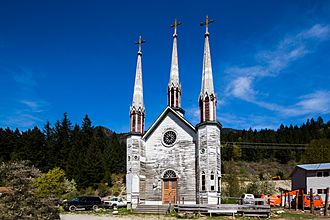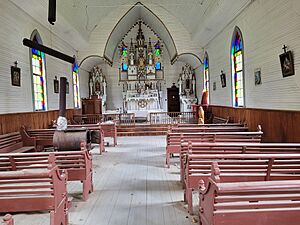Church of the Holy Cross (Skatin) facts for kids
Quick facts for kids Church of the Holy Cross, Skatin |
|
|---|---|
 |
|
| General information | |
| Architectural style | Carpenter Gothic |
| Country | Canada |
| Completed | ca. 1905 |
| Technical details | |
| Structural system | wooden |
| Official name: Church of the Holy Cross National Historic Site of Canada | |
| Designated: | 1981 |
The Church of the Holy Cross is a special place in Canada. It is known as a National Historic Site. This means it is an important landmark in Canadian history. The church is located on land belonging to the Skatin First Nation in southwestern British Columbia.
You can find it on the east side of the Lillooet River. This area was once part of the first inland Gold Rush trail in British Columbia, called the Douglas Road. The Skatin Nation's name for the area is Skookumchuck Hot Springs. "Skookumchuck" means "strong water" in the local language. There are also some fast-moving river sections, called rapids, nearby.
Contents
History of the Church
Early Missions and Worship
Missionaries from the Missionary Oblates of Mary Immaculate first visited the Lillooet River valley around 1860. They set up missions in places like Port Douglas and Skookumchuck Hot Springs. They encouraged the local Indigenous people to live together in small villages.
Older churches in the area are no longer standing. The villages never had a priest living there all the time. Priests would travel through, often only once a year. Because of this, many people would get married or have their babies baptized on the same day. Services sometimes happened outdoors or in the home of a community leader. The community had at least two other places of worship before building the current church.
Building a Special Place
Some families traveled for seasonal work and saw large churches in places like Sechelt, British Columbia and New Westminster. They were also inspired by prayer cards showing pictures of grand European cathedrals. This made them want to build a beautiful church that was also a work of art.
Even though the builders were not trained carpenters, they worked hard. They used the tools they had at the time. Local Indigenous craftspeople spent years creating the church's amazing details. They carved the altar and worked carefully on the wood inside. The church was finished around 1905.
The builders used materials from the local area, like huge trees from the forests. Some wood might have been cut at Port Douglas or even further away. Materials were moved using horse-drawn wagons, rafts, canoes, or carried on people's backs.
A Place for Generations
For many generations, people have been baptized, married, and had funerals at this church. It is still a place of worship and ceremony for people from nearby communities like Samahquam, Douglas First Nation, and Mount Currie.
The Catholic Archbishop blessed the church in 1908. However, the building truly belongs to the communities who built it. Some repair work was done between 1982 and 1984. During that time, elders Henry Peters and Margaret Ann Peters (Williams) celebrated their 51st wedding anniversary. They also had their great-granddaughter, Jessica, baptized there.
A National Historic Site
The Church of the Holy Cross was recognized as a National Historic Site in 1981. It was chosen because of its special Carpenter Gothic style of architecture. This style uses wood to look like stone Gothic churches. The church also has unique hand-carved features inside.
The people who built the church were honored with a bronze plaque on June 22, 2006. This plaque is written in three languages: Ucwalmicwts, English, and French.
Built about 1905 by members of the Stl'atl'imx Nation, the Church of the Holy Cross is remarkable for the beauty and originality of its interior decoration. The craftsmanship of the cedar sculptures, altar, pews, and grave markers of this wooden Carpenter Gothic style building attests to the exceptional skills of the local artisans. The corner towers, rose window, three spires, and arched windows also contribute to the distinctive character of this 'cathedral in the wilderness'
Keeping the Church Safe
Restoration Work
In the winter of 2006, work began to make the church stronger. This included making the inside of the towers and steeples more stable. The next year, work started on the church's foundation. This was finished in 2008. Now, the church stands on strong concrete footings instead of old river rocks.
In some places, the original wood beams supporting the church had rotted. Workers trimmed the damaged ends and added new wood. When the front porch was taken off, a long support beam under the front of the church was found to be badly rotted. To finish the work quickly, a concrete wall was put under the front of the church. The two towers on the east and west sides also now have concrete foundations.
The building now has a stable base. However, the outside parts, towers, and decorations still need more care.
Future Plans and Support
In August 2009, the Ama Liisaos Heritage Trust Society received good news from Parks Canada. The Canadian government offered to help pay for repairs, providing up to $202,060. Volunteers still needed to raise matching funds for the work to continue. An official announcement was made on November 14, 2009.
Since then, emergency work has been done at the church. Damaged windows, trim, and woodwork from the two towers were removed and stored safely. Holes were covered with plywood and special material to keep out bad weather. A team of experts worked on detailed plans for more conservation.
This conservation work will include fixing and replacing decorative trim and the outside covering. They will also repair windows, frames, and repaint the outside. The roof, which is almost 30 years old, will be replaced. The electrical system will be updated, and new safety and fire prevention measures will be added.
The Ama Liisaos Heritage Trust Society is raising money for this work. The total cost is expected to be over $450,000. About half of this will come from the government's cost-sharing agreement. They started an "Adopt a Window" campaign. This allows families and supporters to honor someone special with a memorial plaque. If you want to help save this special site, you can contact the Ama Liisaos Heritage Trust Society. A book called Spirit in the Land: Our Place of Prayer tells the story of the church and its builders.
A local elder explained why the church was built: "They were devoutly spiritual people. Originally, they would have prayed on the land, wherever they were. It was the priests who taught the people to pray in a church. This building has become a centre for our culture and our communities. Our ancestors built this church by working together. It can bring our people back together once again."


